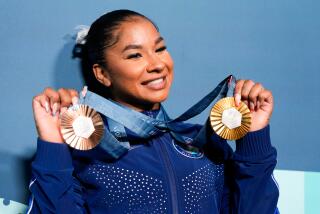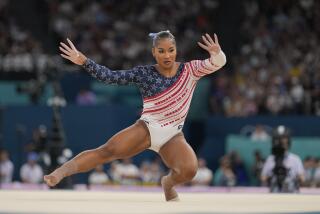Worldwide Perception Is a Harsh Reality for U.S.
- Share via
C.J. Hunter is a huge man. And he was tearful.
Four times during the summer of 2000, the world champion shotputter had tested positive for the banned steroid nandrolone. Wiping away tears at a September news conference at the Sydney Olympics, he said he hadn’t done it, had only taken dietary supplements.
He said he had withdrawn from the Games because of injury, not fear of drug testing.
He got a kiss from his wife, track star Marion Jones. Then she left the room; within months, they were divorced.
Amid the kisses and tears, meantime, who should appear in the room -- in far-away Australia -- but the noted American barrister, Johnnie L. Cochran Jr. “I’m here as a friend of the family,” he said before being swarmed by reporters trying to capture his attention with shouts of “Johnnie! Johnnie!”
The surreal scene helped launch an inquiry commission headed by a Canadian law professor that asked whether USA Track & Field systematically covered up doping results.
A year later, the commission reported there were no systematic cover-ups. But at the same time, it detailed the case of an athlete, identified only as USOC #13, who had tested positive for a steroid before Sydney, been convicted of a doping violation, then, after an appeal, exonerated -- and competed at the Games.
According to documents and statements obtained by The Times, USOC #13 is Jerome Young, winner of the 400 meters at the track and field world championships Tuesday night in Paris.
Young, 27, of Fort Worth, was whisked away for a routine doping check after winning the 400 and was not available privately for comments on the Olympic matter. The Times is not aware of any positive tests or allegations of positive tests concerning Young since 1999.
His case -- previously known as that of the unnamed athlete from Sydney -- has soured relationships between U.S. track and field officials and their international and Olympic counterparts. It has fueled a perception -- which USA Track and Field officials insist is misguided -- that USATF has, to the benefit of American athletes and the U.S. Olympic team, concealed information about U.S. athletes who have tested positive.
A key reason the case remained so charged so long after Sydney is the comparison to a case involving a German track star, Dieter Baumann. The winner of the men’s 5,000-meter run at the 1992 Barcelona Games, Baumann later tested positive -- in October and then November 1999 -- for the banned steroid nandrolone. Young tested positive in June 1999 for the same substance.
The German track and field federation exonerated Baumann; he claimed his toothpaste might have been spiked.
Track’s worldwide governing body, the International Assn. of Athletics Federations, later conducted its own investigation and suspended Baumann for two years -- the typical sanction in a nandrolone case -- prior to the 2000 Games. Because USATF refused to disclose Young’s name, the IAAF did not have the chance to conduct its own inquiry into his case prior to the Sydney Olympics.
“If there is going to be any order in the world, the rules need to apply to everybody,” said University of Texas professor John Hoberman, an expert in doping in Olympic sports.
The case illuminates the currents that drive national and international sports politics and illustrates with uncommon clarity just how many shades of gray there can be in what should be a black-and-white question: Did an athlete cheat?
At issue in the case of USOC #13 are tests conducted June 12, June 26 and July 2, 1999. The first was negative, the second positive for nandrolone, the third negative.
A male athlete tests positive for nandrolone if it registers at a level above two nanograms per milliliter -- two parts per billion. Nandrolone metabolites can show up in an athlete’s system in two ways.
The first is through injection; that method leaves traces of the steroid in the system for weeks or months, said Dr. Don Catlin, head of the Olympic-accredited testing lab at UCLA.
The second, Catlin said, is by taking something orally -- with a trace in the system that lasts just a few days.
In recent years, positive test results have often been traced to a contaminated dietary supplement, anything from a purported muscle builder to a vitamin enhancer that is laced with nandrolone or other banned substances.
A study released by the International Olympic Committee in April, after tests conducted on 634 nutritional supplements bought in 13 countries, found that 14.8% of them were contaminated with substances not included on the product’s label that would have produced a positive doping test.
The source of the nandrolone metabolites in the June 26 test remains unclear. But Dr. Larry Bowers, USATF’s expert witness in the case, “emphasized the magnitude of the prohibited substance found in the test,” according to the doping appeals board. The reading itself remains undisclosed. Bowers declined to comment for this story.
Despite the “magnitude,” the appeals board said that the negative test, six days after the alleged positive test, created “reasonable doubt” about the alleged violation. It reported, “Frankly, the two negative tests sandwiching the positive result prompts many practical questions about the validity of the positive test.”
The hearing and appeal were conducted in secret. The penchant for secrecy is what has frustrated international officials -- and strained relationships between sports officials in the U.S. and their counterparts elsewhere.
At the Salt Lake Winter Games in February of last year, IOC President Jacques Rogge said he found USATF’s position incomprehensible.
“We want to know if he was exonerated, why, and if he was exonerated, why he was allowed to compete,” Rogge said. “I do not understand the position of USATF. They say he was clean but they never gave a reason.”
In April 2002, USATF and the IAAF agreed to submit the dispute to binding arbitration before the Court of Arbitration for Sport, a Swiss-based tribunal. Both sides also agreed that the tribunal’s decision would bring finality to the case.
During a hearing, the name of the athlete was inadvertently blurted out in open court. Even then, in keeping with the secrecy that has attended the case all along, it was not discussed in a wide fashion.
This January, a three-member panel issued a ruling in USATF’s favor. It said that the IAAF could not now get what it wanted from USATF -- because, it said, the IAAF had not been diligent enough through the years in pressing USATF for disclosure. The issue is unlikely to emerge again in this context, because the U.S. Anti-Doping Agency now runs drug testing for Olympic sports in this country -- USATF no longer takes the lead role in cases involving track and field athletes.
But the issue of whether the world believes that the U.S. plays fair is still very much on the agenda.
The IOC even now is pressing the U.S. Olympic Committee for wide-ranging information about the USOC’s anti-doping practices in the past 25 years.
The USOC is due to report to the IOC at the next meeting of the IOC’s ruling executive board, in September at IOC headquarters in Lausanne, Switzerland. Insiders expect the USOC to detail dozens of cases that may have involved banned substances but were not punishable offenses under the rules then in place; any transgressions that went unpunished are expected to be minor.
“We remain committed to an aggressive anti-doping program built on principles of transparency, fairness and adherence to the rules,” USOC spokesman Darryl Seibel said.
“Yes,” Rogge said Tuesday, “transparency is the best way.”
More to Read
Go beyond the scoreboard
Get the latest on L.A.'s teams in the daily Sports Report newsletter.
You may occasionally receive promotional content from the Los Angeles Times.





